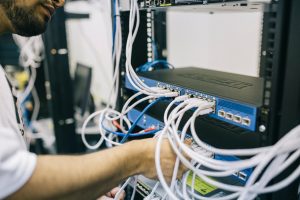Amazon AI and Automation in Logistics Warehousing: The Reality and Ambition of 2025
If Amazon was a “bookstore” twenty years ago, then in 2025, it has long since transformed into the world’s most tech-powered logistics machine. In AI and automation, Amazon not only leads the e-commerce industry but has also set new standards in warehousing and logistics.
Yet when people say “Amazon’s warehouses are advanced,” they often just have a vague impression. What exactly makes it advanced? How does AI drive logistics efficiency? Has automation truly replaced human labor? Let’s break it down in depth.
1. The AI Dispatch Brain: Not a Pile of Robots, but an Intelligent System in Command
In 2025, Amazon operates over 1,100 fulfillment and sortation centers globally, processing more than 35 million packages per day. You might think it’s just tens of thousands of robots mindlessly moving packages, but the truth is far more complex.
Amazon’s AI dispatch system, called “Monarch”, not only controls robot paths and order prioritization, but also predicts demand peaks, allocates inventory intelligently, and even dynamically adjusts warehouse layouts through machine learning.
Here’s an example:
During Black Friday 2024, Amazon’s AI identified a spike in Echo device search traffic in certain California cities three weeks in advance, and proactively moved inventory closer to those areas to avoid warehouse congestion and delays. This wasn’t about predicting the future—it was about optimizing the present.
2. The Evolution of Kiva Robots: From Movers to Warehouse Collaborators
Back in 2012, Amazon acquired Kiva Systems for $775 million and began transforming its warehouses with automation. By 2025, Kiva has evolved into the Proteus robot, with improved navigation and autonomous obstacle avoidance, capable of operating safely among human workers.
Latest data shows Amazon has deployed more than 750,000 mobile robots globally, including:
- Proteus – autonomous navigation, replacing manual pallet transport
- Cardinal – robotic sorting arm powered by AI vision
- Sparrow – can recognize and pick over 1,200 different products
- Sequoia system – launched in 2024, shortens the receiving-to-packing workflow by 25%
What truly matters isn’t the robot hardware, but the AI decision layer behind it. For example, Sparrow uses computer vision and deep learning to calculate the most stable and efficient way to grasp each item.
3. AI Vision Recognition: For Product Identification, Quality Control, Even Theft Prevention
Traditional warehouses fear mis-shipped items and incorrect labeling. At Amazon, such errors are rapidly decreasing—and the reason is full-scale deployment of AI vision technology.
In 2025, around 80% of Amazon’s large U.S. warehouses are equipped with AI visual inspection systems, combining depth cameras with machine learning algorithms, enabling:
- Automatic detection of package defects and labeling mistakes
- Order accuracy verification with a success rate of over 99.7%
- Anomaly detection to prevent internal theft or human error
In some facilities, the system can even assess whether packaging is oversized—enabling greener packaging and logistics.
4. The Last Mile: AI-Optimized Routing and an Autonomous Fleet Are Underway
The “last mile” has always been the pain point of logistics costs, but Amazon’s AI is shrinking that cost year by year.
Across North America and Europe, Amazon has rolled out an AI-driven routing system called Amazon Last Mile Routing Optimization (LMRO), which leverages:
- Real-time traffic data
- Weather forecast models
- Historical delivery performance
- Driver behavior and efficiency patterns
The system generates optimized delivery routes for hundreds of thousands of drivers daily. Internal Amazon reports show LMRO saves over $150 million annually in transportation costs.
Meanwhile, Amazon is expanding testing of its Zoox autonomous delivery fleet, aiming to achieve fully driverless delivery in select areas by 2026. While not yet mainstream, it’s likely to roll out significantly within two years.
5. Has AI Truly Replaced Humans? Amazon’s Reality Is More Nuanced
This is a question no one can avoid. In 2025, the number of robots in Amazon’s warehouses has outpaced human workers—but that doesn’t mean humans have been entirely replaced.
- Amazon remains one of the largest private employers in the world, with over 900,000 warehouse workers in North America alone
- Automation hasn’t reduced total headcount but has shifted job roles—less picking and lifting, more machine monitoring and maintenance
- Amazon’s reskilling program launched in 2024 has trained around 100,000 employees to transition into tech and robot-assist roles
In other words, humans and AI aren’t binary opposites—they now co-exist in a highly efficient ecosystem.
Will AI Replace Human Jobs? 5 Key Questions Answered for 2025 & Beyond
Conclusion: Amazon Isn’t the Future—It’s the Extreme Edge of the Present
Amazon’s application of AI and automation in warehousing and logistics has evolved from “pilot tests” into a new industry standard. In this vast machine-driven system, every robot, every picking motion, every delivery route isn’t a standalone task—it’s the result of thousands of instant AI-driven decisions happening in real time.
It’s not the future—it’s the present, taken to the technological extreme.
As for other e-commerce platforms: can they keep up? That’s an entirely different question.
How AWS Is Driving Amazon’s Profit Growth in 2025
Amazon Growth Strategy: AI, E-Commerce & Logistics in 2025
Jeff Bezos and Amazon’s Growth Strategy: The Blueprint Behind Success



